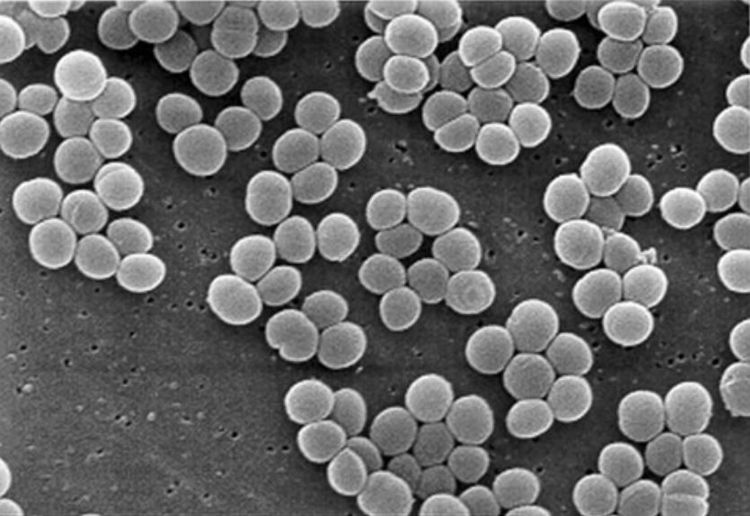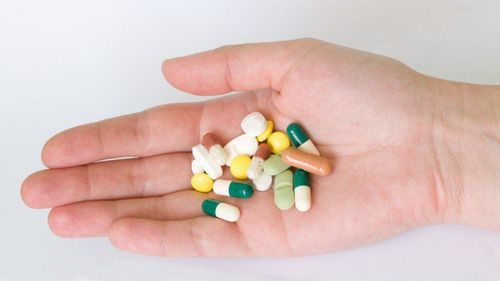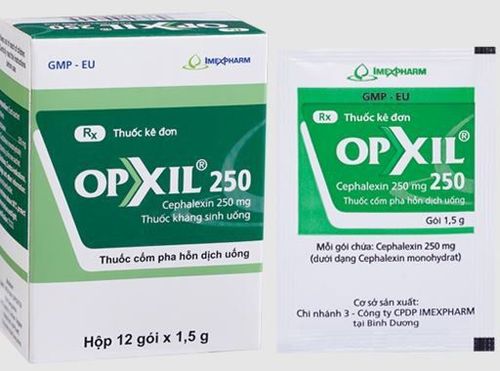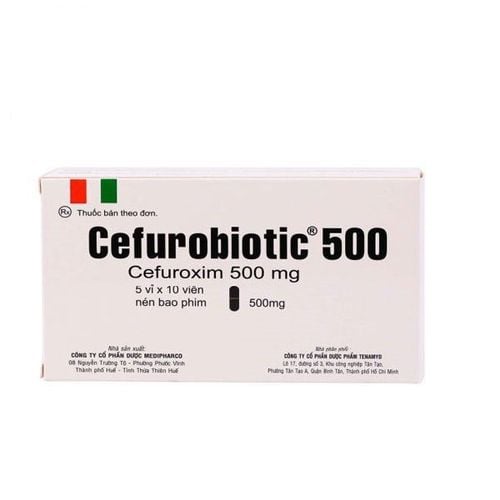This is an automatically translated article.
Cephalosporin is known as an antibiotic, which is divided into several different drug groups. With each group of drugs, the way of use is also different, it is necessary to follow the doctor's instructions, do not arbitrarily use the drug without a doctor's prescription.
1. What is Cephalosporin?
Cephalosporin is a broad-spectrum beta-lactam antibiotic, a derivative of 7-aminocephalosporanic acid. Different Cephalosporins are formed by semi-synthetic methods, the process of changing the substituents will lead to changes in the properties and biological effects of the drug.Cephalosporins have a bactericidal effect and act similar to penicillin, helping to inhibit bacterial cell synthesis. Besides, Cephalosporin also has the ability to acylation of D - alanin transpeptidase, inhibiting the final stage of bacterial cell wall synthesis. From there, cell wall biosynthesis is stopped and bacteria without cell walls are destroyed.
2. Classification of Cephalosporin antibiotics
Cephalosporins are classified based on their antibacterial spectrum. Types of Cephalosporins include:
1st generation Cephalosporins; 2nd generation cephalosporins; 3rd generation cephalosporins; 4th generation cephalosporins; 5th generation cephalosporins. The previous generations have stronger effects on gram-positive bacteria, but weaker gram-negative bacteria than later generations and vice versa.
2.1. 1st generation Cephalosporin drugs Cefazolin, Cephalexin, Cefadroxil, Cephalothin,... will belong to the 1st generation Cephalosporin drug group. These drugs have strong activity against Gram-positive bacteria strains but relatively weak activity on other strains. strains of Gram-negative bacteria.
Almost Gram-positive cocci will be sensitive to 1st generation cephalosporins (except enterococci, S. epidermidis and methicillin-resistant S. aureus). Especially the anaerobic bacteria in the oral cavity are sensitive, however, the first generation Cephalosporins are not effective against B. fragilis.

Thuốc kháng sinh Cephalexin thuộc nhóm thuốc Cephalosporin thế hệ 1
Indications
1st generation Cephalosporin is used for the treatment of common infections caused by susceptible bacteria such as:
Respiratory and ENT infections. Urinary and genital infections. Infections of the skin, soft tissues, bones, teeth. Side effects of Cefotaxime – Cephalosporin 1st generation
Allergic reactions: itching, skin rash,... more severe than anaphylaxis but less common; Nephrotoxic drugs can cause interstitial nephritis; Digestive disorders such as nausea, abdominal pain, diarrhea; Fungal superinfection in the mouth, vagina, pseudomembranous colitis. 2.2. 2nd generation Cephalosporin drugs Including 2nd generation Cephalosporins including Cefoxitin, Cefaclor, Cefprozil, Cefuroxim, Cefotetan, Ceforanid,...
2nd generation Cephalosporins have stronger activity on Gram-negative bacteria than the 1st generation, but much weaker than 3rd generation Cephalosporins. Some drugs such as: Cefotetan, Cefoxitin also have activity on B. fragilis. Second generation cephalosporins are also ineffective against Pseudomonas and Enterococcus.
Indications
2nd generation Cephalosporins are often used in the treatment of common infections caused by susceptible bacteria such as:
Respiratory and ENT infections. Urinary and genital infections. Skin, soft tissue, bone, and roasting infections. Undesirable side effects
Unexpected side effects when using 2nd generation Cephalosporins are similar to 1st generation Cephalosporins. However, Cephalosporins with Methylthio tetrazol group such as Cefotetan, Cefmetazole... can dissolve prothrombin, so they cause coagulation disorders. In addition, the second generation Cephalosporin can cause Disulfiram-like syndrome, so it is necessary to avoid drinking alcohol and alcohol-containing drugs while taking the drug.

Người bệnh cần hạn chế tối đa việc sử dụng chất kích thích khi đang dùng thuốc
2.3. 3rd generation Cephalosporin drugs 3rd generation Cephalosporin drugs include Cefotaxime, Cefpodoxime, Ceftibuten, Cefdinir, Cefditoren, Ceftizoxim, Ceftriaxon, Cefoperazone, Ceftazidim,...
In general, 3rd generation cephalosporin drugs have less activity than 1st generation drugs. on Gram-positive cocci, but possessing strong activity against bacteria of the Enterobacteriaceae family. Some drugs such as ceftazidime and cefoperazone are active against P. aeruginosa but are inferior to other drugs of the same 3rd generation on Gram-positive cocci.
Indications
3rd generation Cephalosporin drugs are used in case of severe infections caused by bacteria resistant to 1st and 2nd generation Cephalosporins such as:
Meningitis, brain abscess; Sepsis ; Severe respiratory infections; Inflammation of the endocardium; Gastrointestinal infections, urinary tract infections; Urinary and genital infections. Side effects of Cephalosporins are similar to those of 1st and 2nd generation Cephalosporins.
2.4. 4th and 5th generation cephalosporins drugs 4th generation cephalosporins
4th generation of cephalosporins include the drugs cefepime and cefpirome. 4th generation cephalosporins have a broader spectrum of activity than 3rd generation cephalosporins and are also more stable to beta-lactamases (but not to Klebsiella pneumoniae carbapenemase (KPC) group A).
4th generation cephalosporins are active against both Gram-positive and Gram-negative strains (including Pseudomonas, Enterobacteriaceae).
5th generation Cephalosporins
5th generation cephalosporins are Ceftaroline, which is effective against methicillin-resistant Staphylococcus aureus (MRSA).

Vi khuẩn Staphylococcus aureus bị tiêu diệt bởi thuốc Cephalosporin thế hệ 4 và 5
Mechanism of resistance to cephalosporins is also the mechanism of resistance to β-lactams in general. Many bacteria secrete β-lactamases that modify or inactivate antibiotics. Specifically as follows: In Gram (+)
Enzymes are inducers, the bacteria only produce enzymes in the presence of antibiotics. The enzyme is released to the extracellular space, inactivating the antibiotic before the drug enters the bacterial cell. In gram (-) bacteria
Enzymes are produced continuously even in the absence of antibiotics. The enzyme is stored in the periplasmic region, so the resistance mechanism of gram(-) bacteria is more effective. How to use Cephalosporin antibiotics provided above is for reference only. Based on your medical condition and the specific instructions of your doctor to use the most appropriate Cephalosporin group of drugs.
Any questions about this drug, you can contact Vinmec International General Hospital for support from leading experts in the industry.
Vinmec International General Hospital is one of the largest and most prestigious medical facilities in Vietnam. There is a system of well-qualified, experienced doctors and medical professionals with high academic degrees and a heart - reach for the profession. Vinmec is equipped with a team of doctors and nurses that are not only famous in the country but also include prestigious doctors from Japan and Singapore to bring the most effective and advanced treatment regimens.
In addition, the system of equipment is equipped with modern and advanced world, effectively supporting the process of diagnosis and effective treatment of diseases. The facilities are complete, spacious and clean, meeting the standards required by the Ministry of Health, on par with developed countries.
If you have a need for consultation and examination at Hospitals under the national health system, please book an appointment on the website to be served.
Please dial HOTLINE for more information or register for an appointment HERE. Download MyVinmec app to make appointments faster and to manage your bookings easily.













